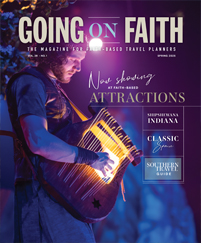One far-reaching vista of a prairie, sand dunes or craggy mountains can instantly remind people of the truly remarkable nature of this planet. Those unforgettable landscapes — preserved as national parks and monuments for their hidden caves, stunning deserts, fossilized creatures and other blockbuster outdoor attractions — help connect visitors with the marvels God has created.
Some of the most stunning protected sites lie in the mountain region of the country. Faith-based groups need not settle for only the most famous national parks; they should also consider some of the region’s lesser-known parks and monuments that boast a fraction of the crowds and equally impressive natural wonders.
Church groups can feel like explorers as they survey the untouched panoramas at lesser-known parks such as Wind Cave National Park, Great Sand Dunes National Park, Fossil Butte National Monument, Craters of the Moon National Monument and Theodore Roosevelt National Park.
Wind Cave National Park
[ Hot Springs, South Dakota ]
In 1881, Jesse and Tom Bingham accidentally discovered a cave by following the whistling sound of the air blowing out the entrance. The force of the wind even blew off Tom’s hat. Later, when Jesse returned, he could not understand why the wind had switched directions to suck his hat into the cave.
Those intriguing wind patterns are only one fascinating aspect of Wind Cave National Park.
“Coming here is like visiting two parks at once,” said Thomas Farrell, chief of interpretation at the park. “Aboveground, we have a preserved mixed-grass prairie, and belowground, we have one of the world’s largest caves.”
Groups can choose from a number of tours that explore the sixth-largest cave in the world. The ranger-led tours journey, with varying difficulty levels, into different areas of the cave’s labyrinth, but all of the tours feature some of the Wind Cave’s unusual box-work formations. Guides explain how the intricate honeycomb-patterned box-work formations develop, and point out other notable formations, such as cave popcorn, flowstone and frostwork.
Aboveground, the Wind Cave Visitor Center introduces guests to the 33,000-acre park with exhibits on cave exploration, cave formations and park wildlife. Guided prairie hikes leave from the center in search of birdlife; the rolling prairie of the southern Black Hills supports a variety of bird species.
“Not a lot of people know about us, but there is a lot to do here,” said Farrell. “We have great wildlife opportunities. You can be just riding down the road, and there is a buffalo or pronghorn very close by.”
Great Sand Dunes National Park
[ Mosca, Colorado ]
Although the Great Dunes National Park is located in the middle of a desert inside a landlocked state, people in swimsuits flock to it each spring for a seasonal beach that is created by water flowing off the mountains. Water surges similar to waves make the park’s Medano Creek seem like a true beach, with more than enough sand to build a sand castle.
A beach inside a landlocked dune field is not the only juxtaposition visitors will notice on a trip to the park.
“The first things you see are the dunes, which are larger than most buildings you see in cities,” said Patrick Myers, park ranger. “Behind the dunes are snowcapped mountains. This combination gives people a sense of wonder and awe.”
Locals helped save the tallest dunes in North America when gold mining and concrete-making enterprises threatened to destroy them in the 1920s. The site became a monument in 1932 and expanded into a national park in 2004.
Groups have a number of options for experiencing the dunes, including horseback riding, ATV tours and hiking. A two-hour round-trip hike to High Dune offers a panorama of the entire dune field.
“There are trails here, but you can always go off-trail,” said Myers. “There is a sense of freedom and a sense of exploration. You can really get your hand into the environment and play in it.”
Many visitors choose to interact with the surrounding dunes by sliding on sand boards and sand sleds. Groups can rent these two types of boards from many retailers in the San Luis Valley, who can provide tips for first-timers looking to inject a little excitement into their park experiences.










